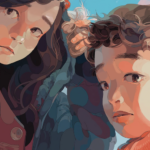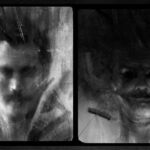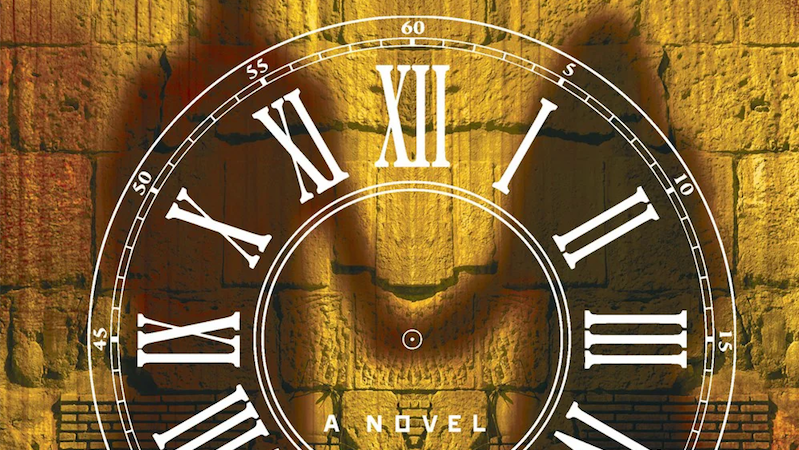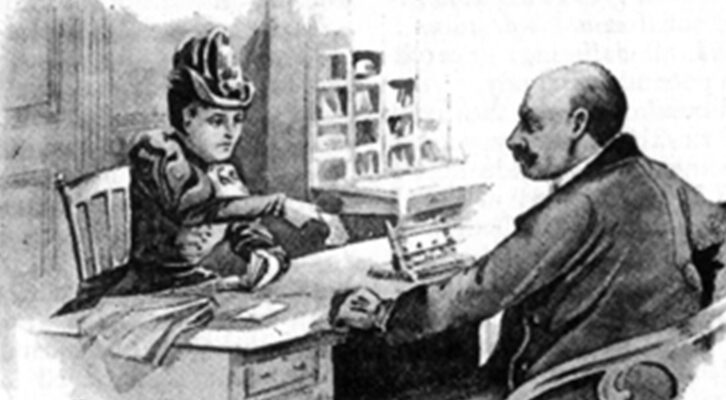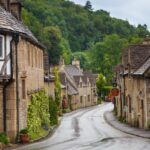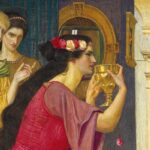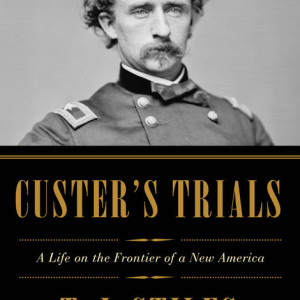The Joy of Writing about The Joy of Painting
In Which Bob Ross is Compared to God, Creator of Worlds
The following appears in the current issue of The Lifted Brow.
I’m so glad you could join us today. I’ve started by preparing a new document on Microsoft Word. We don’t need anything too fancy for what we’re doing: this Microsoft Word is from 2011, Version 14.4.5. We’ve got ourselves a keyboard, and on that keyboard we’ve got 26 letters—we’ll need all of them today and some punctuation marks, too. But all you really need is your imagination and a little love in your hearts.
Maybe we’ll start with a brief biographical sketch, right here:
Bob Ross was a painter who hosted an instructional program on American public television from 1983 to 1994 called The Joy of Painting.
Ain’t that neat? Right before your eyes you’ve got yourself a real life person starting to show up on your page. Now let’s just fill this in a bit more:
A kindly man with a soft voice and a permed afro, Ross spent each episode gently ushering viewers through the process of painting, promising to teach anyone how to create a landscape of happy little trees, calm streams and almighty mountains in just under half an hour.
Tap those keys on that keyboard gently—tap, tap, tap—not even pressing real hard, just let it come to you.
Broadcast on 95 per cent of all public television channels in the United States at its peak, reaching an estimated 100 million American households per week, The Joy of Painting eventually made its way to more than 20 countries across the world, including Iceland, Iran, Holland, Costa Rica and Japan.
Today, 20 years after his death, Ross endures as a cult icon.
We’ve got ourselves a background already. So I’m gonna add to it a rhetorical question:
But how does one go about painting a portrait of Bob Ross through words?
My oh my. This rhetorical question is going to need a friend in the form of an answer or at least some kind of positioning statement so we’ll just pop one right here:
That’s easy: do it the way Bob Ross would do it. That is, through a series of lessons that guide you through the process itself. That way, as we talk about Bob Ross, we’ll also be demonstrating the strengths of Ross’s method: his friendliness, warmth and accessibility, the gentle and encouraging paternal instruction, the endearing but not cloying amount of dagginess. At the same time, the weaknesses of this technique will reveal the weaknesses of Bob Ross: this technique is gimmicky, lazy, shallow, a magician’s trick, all style and no substance.
Let’s get started.
The Joy of Art History
Here’s a tricky little term: alla prima. It’s Italian for “at first attempt” and it refers to the layering of wet paint upon wet paint. Some folk prefer to just call it “wet-on-wet painting” and that’s just fine, too.
Start with one of those terms—alla prima or wet-on-wet painting, whichever one you prefer—and just blend a few centuries of art history together on the page, there you go, noting the technique’s use from early Netherlandish painters to Spanish Baroque painters to late Rococo and late Venetian School painters, easy does it, all the way through Modernism—Impressionism, post-Impressionism, Realism, Expressionism, Abstract Expressionism—before stopping at a painter on American public television in the 1980s and 1990s.
There. Don’t be shy now. Grab some contrariness and splash it across the page:
Painting is beside the point: the paintings in The Joy of Painting don’t matter.
That might look ugly or nasty for now but that’s just because we aren’t finished yet. Be patient. Back up the statement:
Arguably the word “painting” in the title The Joy of Painting refers not to the noun “painting”—the thing of painting as work of art—but to the verb “painting”—the act of painting as work of art. After all, the bulk of the show concerns itself with the process of painting, only unveiling a finished product as the end music starts and the closing credits roll.
Oooh we sure are getting somewhere now. Pick up your two-inch Background Brush, the widest of all Bob Ross brushes, because we will be making some very broad brush strokes here.
In this sense, Bob Ross belongs to the legacy of action painters such as Jackson Pollock, whom Ross once derisively and perhaps unfairly misremembered as “Jackson Pollard.” The words of American critic Harold Rosenberg, who coined the term “action painting,” are instructive here. He described the canvas in the age of action painting as “an arena in which to act,” saying that “What was to go on the canvas was not a picture but an event.”
Ross’s paintings, then, are only the aftermath of an event—the residue of his performative artwork. But where other action painters tended towards abstraction, Ross straddles figuration. His simple landscapes with their lack of accurate rendering are actually a hyper-effective distillation of his calming manner and method into a representational framework. A happy little tree is more than just a happy little tree: it is the encouragement that you too can paint a happy little tree, it is the supreme ease with which Ross paints a happy little tree, it is the soothing voice that tells you to “paint a happy little tree.”
The Joy of God
Pop culture references are a real nice way to keep it fun. So let’s start by sprinkling some scenes from British sitcom Peep Show, from the episode “The Interview.”
Jez is sitting on the couch, flipping through TV channels, when The Joy of Painting appears.
“Blimey, what’s God up to?” he asks, referring to Bob Ross.
Later in the episode, Jez is back on the couch, flipping through TV channels again, while Mark tosses up whether or not to call his work crush Sophie.
“Okay, listen,” Mark says. “If God’s doing mountains or sky or water, I’ll call; if he’s doing trees or critters, I won’t.”
“Alright, let God decide,” Jez replies.
They turn on The Joy of Painting and, sure enough, God is painting some clouds in the sky and Mark calls Sophie.
Ain’t that just a sweet conceit? It’s a silly little joke but it’d be nice to just flesh that out more.
The God comparison isn’t that farfetched. Consider Genesis. Ross’s emphasis and approach when creating a painting in some ways mirrors the story of creation. There’s the speed: God created the world in seven days; it takes Ross less than 30 minutes. And Ross’s focus on process not outcome and his reluctance to hone in on too fine a detail can be construed as an appreciation of the miracle of creation, as opposed to the minutiae of creation, above all else. There’s no florid description of the infinitesimal fractal striations on leaves in Genesis: God just said, “Let there be,” and there it was and it was good and that was that.
You won’t be able to see this on my page now but in an early draft I made the argument that Bob Ross could in fact have been a manifestation of God or at the very least Jesus, especially when considering the way his afro forms what looks like a halo in Greek religious iconography and the fact that he was at one stage a carpenter.
But none of that is a strong argument now, is it? We’re going to leave it out, but we aren’t going to call it a mistake: there are no such things as mistakes, only happy accidents. As when painting, when writing we can just cover up our early happy accidents. I’m going to go right over that early paragraph with a new paragraph, a reimagining of Genesis:
1:1 In the beginning Bob Ross created the heaven and the earth.
1:2 And the canvas was without paint, and void; and darkness was upon the backdrop of the WNVC studio in Falls Church, Virginia. And the Spirit of Bob Ross moved upon the airwaves of American public television.
1:3 And Bob Ross said, Let there be a happy little tree: and there was a happy little tree.
1:4 And Bob Ross saw the happy little tree, that it was good: and Bob Ross divided the happy little tree from an almighty mountain and maybe an old wood cabin just over here.
That’s just a bit of fun there. We gotta make ourselves smile from time to time. But let’s get back to business and finish the thing:
Ross was a mortal man, but he was a mortal man possessed of the powers of the divine. It’s worth considering Isiah 40:6-8, which reads, “All people are like grass and all their glory is like the flowers of the field; the grass withers and the flowers fall, but the word of the Lord endures forever.”
This analogy is especially apt when skimming through all 403 episodes of The Joy of Painting—eleven years of Ross’s life condensed to an approximate total running time of eight days, nine hours and thirty minutes. There are cyclical and seasonal changes, like the blooming and withering of flowers and trees: Ross’s jeans wax and wane between dark and light blues and his dress shirt occasionally blossoms from staid white into vivid pinks, all while his afro expands and contracts, sometimes presenting as a tightly coiled, desultory dark brown, sometimes as an electric, wiry profusion glowing with hot streaks of light brown.
That’s real nice. Now the final strokes:
Other changes are permanent and irreversible. That is, Ross withers. His beady eyes retreat into a nest of wrinkles, white creeps into his whiskers, the softness of his voice wilts, becoming more a weak softness than a calm softness. The one thing that remains constant and unchanging are the paintings. The happy little trees of Bob Ross endure forever.
The Joy of Humanity’s Adverse Impact on the Environment
We’re gonna have ourselves a little fun now and do something different: we’ll be painting a picture using only numbers.
Some of these numbers I’ve taken from Walt Hickey’s “A Statistical Analysis of the Work of Bob Ross” from statistical blog FiveThirtyEight; the rest took only a moment to google. Some are odd, some are even—makes no real difference. You can choose whatever numbers you want for your own essay. Remember: You can do anything you want, this is your world.
Percentage of Bob Ross’s paintings with at least one happy little tree: 91%
Percentage of Bob Ross’s paintings with at least two happy little trees: 85%
Probability that Bob Ross, having painted one happy little tree, will paint another happy little tree: 93%
Percentage of the world’s land mass that is covered in happy little trees: 31%
Percentage of the world’s natural forests that have already been destroyed: >80%
Percentage of deforestation that is caused by either subsistence farming, commercial agriculture, logging and fuel wood removal: 99%
Percentage of Bob Ross’s paintings that feature the visible presence of people: 0.52%
The Joy of Voice
Seeing as we had some practice using numbers just then, we’re going to try them again for this part. Those of you just tuning in now, don’t fret: it’s a small one, a little one-digit critter. We’re going to pop it right in the middle of our opening sentence:
Bob Ross once claimed that only three per cent of his viewers actually painted along with him.
That wasn’t too hard now, was it? Let’s try a double-digit:
That leaves 97 per cent of Ross’s viewers without brush or paint or canvas in hand. What were they doing?
It’s all coming together, get yourself started on that answer:
Leaving aside the fact that some want to literally watch paint dry, most watched for relaxation purposes. The calming qualities of the show can be almost wholly attributed to Ross’s voice, which Alessandra Stanley, in an article for the New York Times, described as “the aural equivalent of Demerol.”
One could even argue that his voice was the most painterly aspect of the entire show: his smooth drawl mimics the viscous, mellifluous ooze of paint, while the subtly scratchy burr that undercuts his voice blends in with the sounds of a brush or knife scratching against the canvas. And still, that only goes part of the way towards explaining his voice’s narcotic effects.
Okay, we’re all set up and ready to go. Let’s put this part aside and jump into some fine detailing for a bit. We’ll bring in an expert to cast an authoritative hue on this little scene.
Ross’s Southern accent could be a factor. Linguist Lee A. Pederson believes it is an accent far superior to the Northern accent.
“The North,” he says, “was largely settled by immigrants who learned English as a second language and were heavily dependent on the written word. Southerners, on the other hand, have always relied on the spoken word. In that respect, Southern speech is closer to the native speech of England, and often to Elizabethan England. It is a much more sensitive and effective medium of communication than Northern speech, for the most part, because it is so rooted in the spoken word.
“Southern speech is also noted for being more melodious and various than other dialects because the vowels are long-embraced.”
Oh, that’s nice, all that detail really makes it pop. Keep filling it in.
The prevalence of glide deletions before voiced consonants, pin-pen mergers, vowel breaking and vowel elongation in Ross’s speech seems to indicate he is a speaker of the Lowland Southern dialect specifically. Cropping up in areas that had a high proportion of slaves in pre-Civil War times, it is essentially a living trace fossil of the movements of America’s slaveholding aristocracy, who spread the dialect to regions suitable for plantation-style agriculture and steered clear of the mountainous and drier areas that are now, as a result, dominated by the Inland Southern dialect.
Found in great swathes stretching across parts of Texas, Missouri, Illinois, Indiana, Ohio, Arkansas, Louisiana, Mississippi, Alabama, Tennessee, Kentucky, West Virginia, Maryland, Delaware and Georgia, the Lowland Southern dialect begins to peter out just below Daytona Beach, Florida—Bob Ross’s hometown. Could this imply that the calming properties of Ross’s voice are, at least to some degree, the result of a false nostalgia for a time fraught with deeply troubling moral failures?
The Joy of the United States of America
Pop some Bright Red, Titanium White and Phthalo Blue on your palette and let’s paint ourselves a picture of Bob Ross as a symbol of both the light and dark side of the American experience.
In The Accidental Masterpiece: On the Art of Life and Vice Versa, former chief art critic for the New York Times Michael Kimmelman—“the most acute American art critic of his generation,” according to Robert Hughes—describes Ross’s landscapes as “resolutely American”; in an article for the New York Times titled “The Master of Creation in 26 Minutes,” he calls the entire Bob Ross phenomenon “quintessentially American.”
Throughout the book and the article, Kimmelman draws parallels between Ross and both contemporary and historical American values. Referring to the fact that Ross produced more than 30,000 paintings over the course of his life, Kimmelman notes a “Yankee work ethic,” which can be traced back to the influence of Puritanism in the New World; looking to more recent times, Kimmelman says Ross’s promise of instant gratification—paint a picture in under 30 minutes!—isn’t “so different, ultimately, from what MTV offers.”
The strongest link Kimmelman suggests is the one between The Joy of Painting and the spread of therapeutic recreation in the United States after the 1940s, when the forty-hour, five-day workweek gave rise to a middle class with time and money to burn. Painting in particular, and painting-by-numbers especially, “was a natural fit for a society looking for a bit of self-expression but reluctant to stray outside the bounds.”
We got ourselves quite a lot of Kimmelman on the page. That’s okay, he’s alright. But maybe we should mix it up. Put your own reflections down, whatever you think might be relevant:
There’s the fact that Ross was a military man: he joined the United States Air Force at the age of 18 and served for 20 years, reaching the rank of master sergeant. He was an enterprising, self-made man, too, who only permed his hair to save money and who, with that thriftiness and some hard work, built a million-dollar business. He died on the Fourth of July.
You need to have dark in order to show light. Not too much—this is a happy place—but enough so our light will show. Let’s dive a little deeper, get some of that really dark dark, an almighty dollop of the blackest of Midnight Black, and put something here like:
We can’t talk about Ross without also mentioning William Alexander, a man born to a poor family in a small East Prussian village in 1915, surrounded by the desolation of the First World War. “Nothing but dead cows and machine guns bared and lying around and skeletons of soldiers half-buried with boots sticking out of the ground,” he later wrote.
Even so, he joined the Wehrmacht by the time the Second World War rolled around and was captured by Patton’s Third Army while fighting on the Eastern Front. Upon his release, he immigrated to the United States of America. There, he gave lessons on his quick and easy painting technique and, from 1974 to 1982, hosted an instructional television show on PBS called The Magic of Oil Painting, wherein he taught viewers how to paint landscapes in just under 30 minutes. One of his students was a young US serviceman called Bob Ross.
Speaking to the New York Times about how his former student allegedly copied his technique and became a direct competitor, Alexander said, “He betrayed me.” The betrayal, however, speaks to far more than just a personal spat. It’s emblematic of America’s dark history of looting and plundering, filtered through the modern sheen of neocolonialist appropriation.
Alright, let’s not fiddle this to death. We’re gonna wind this up and save the document onto our desktop. For our earlier drafts we already used the filenames ‘Bob Ross rough draft’, ‘Bob Ross draft’ and all the ‘Bob Ross final’s—‘Bob Ross final 1’, ‘Bob Ross final 2’, and ‘Bob Ross final 3’, even ‘Bob Ross final 3.1’ and ‘Bob Ross final 3.2’—so I’m going to call this one “The Joy of Writing about The Joy of Painting.”
Now get your email client—any will do—and create a new email, attach this document right in there and get that email pointed at the email address of the editor. You can sprinkle a little “Hope you’re really well!” and “I’m at my computer if there’s anything you’d like me to look at,” and, for good measure, “Again, I’m so sorry it’s so late,” then hit Send. There. That’s done. A fantastic essay in just 30 minutes.
From all of us here, I’d like to wish you happy writing and God bless, my friend.






